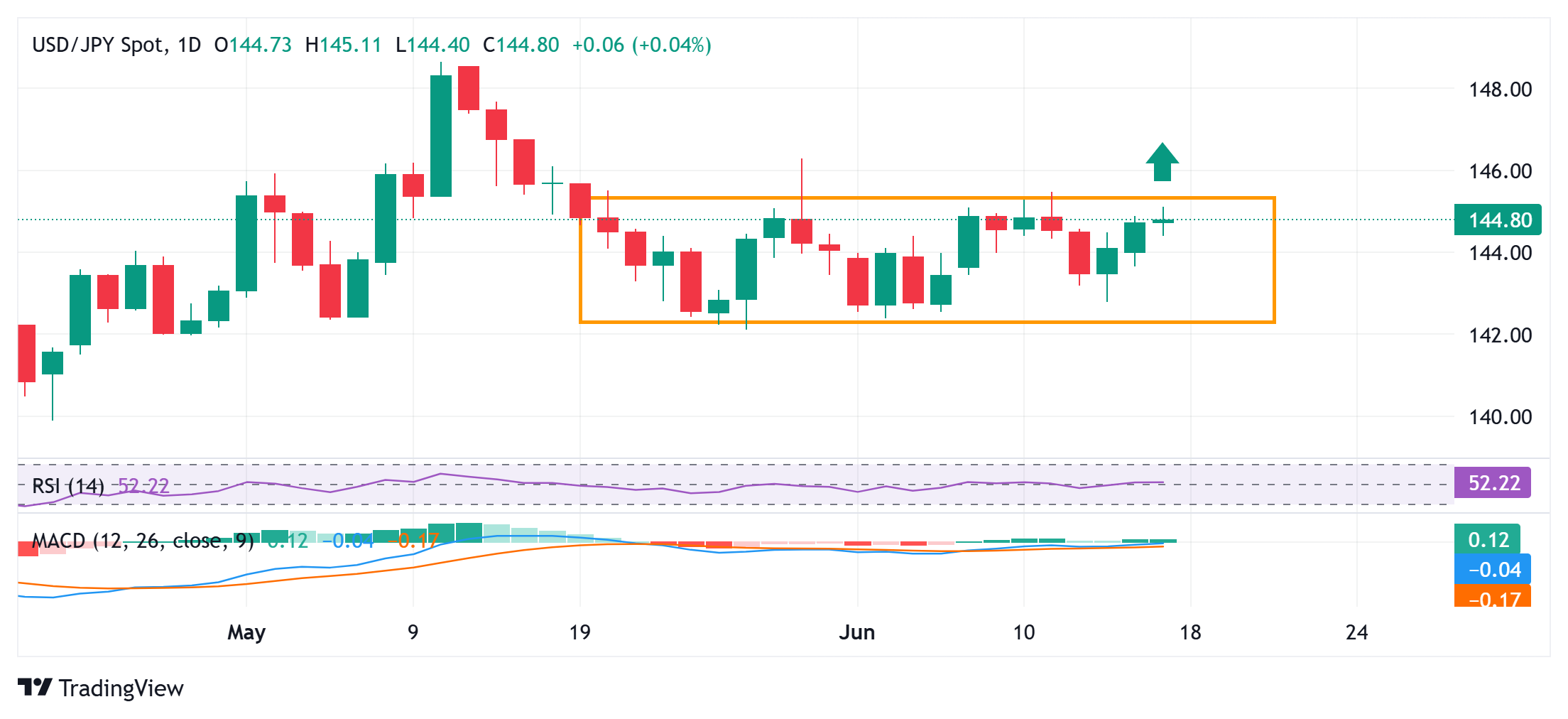
- USD/JPY seesaws between tepid gains/minor losses through the early European session.
- The BoJ policy update does little to provide any impetus amid rising geopolitical tensions.
- Traders also seem reluctant and opt to wait for the critical FOMC decision on Wednesday.
The USD/JPY pair struggles to capitalize on its intraday uptick and retreats slightly from levels above the 145.00 psychological mark on Tuesday following the Bank of Japan’s (BoJ) unanimous decision to leave the policy rate unchanged at 0.50%. Apart from this, the BoJ announced that it will reduce the monthly outright JGB purchases to about ¥2 trillion in January-March 2027. The amount will be cut down by ~¥400 billion each calendar quarter until January-March 2026 and then by ~¥200 billion each calendar quarter from April-June 2026.
In the post-meeting press conference, BoJ Governor Kazuo Ueda said that the bond tapering decision is not so much about fiscal considerations but mainly to avoid excessive volatility from negatively impacting the economy. Ueda further added that trade developments remain extremely uncertain, and the central bank will guide monetary policy from the standpoint of achieving price targets sustainably and stably. Meanwhile, Ueda showed readiness for further rate hikes depending on the likelihood of achieving the central bank’s outlook.
This, along with rising geopolitical tensions in the Middle East, lends some support to the safe-haven Japanese Yen (JPY) and acts as a headwind for the USD/JPY pair amid the underlying bearish sentiment surrounding the US Dollar (USD). The deadly aerial conflict between Israel and Iran has entered its fifth day, with both sides widening their attacks and exchanging a new wave of missiles. Israel struck Iran’s state-run television station on Monday, while Iran said that it is preparing for the largest and the most intense missile attack in history on Israeli soil.
Meanwhile, three tankers are reportedly on fire in the Gulf of Oman near the strait of Hormuz, raising concerns of a wider conflict in the region. Moreover, US President Donald Trump left the G7 Summit a day early and requested the National Security Council to convene in the Situation Room. This keeps investors on edge and the geopolitical risk premium in play, which, in turn, could underpin the JPY. The USD, on the other hand, languishes near a three-year low amid bets that the Federal Reserve (Fed) would lower borrowing costs further in 2025.
Traders, however, seem reluctant and opt to wait for the outcome of a two-day FOMC policy meeting on Wednesday before placing fresh directional bets. The Fed is widely expected to maintain the status quo and keep its benchmark rate unchanged amid concern that Trump’s tariffs could push up consumer prices. Hence, the focus will be on the accompanying policy statement and Fed Chair Jerome Powell’s comments at the post-meeting press conference. Investors will look for cues about the rate-cut path, which should influence the buck and the USD/JPY pair.
In the meantime, persistent trade-related uncertainties should keep a lid on any meaningful JPY appreciation. In fact, Japan’s Prime Minister Shigeru Ishiba and US President Donald Trump failed to achieve a breakthrough on tariffs at the G7 summit. Ishiba wants Trump to eliminate 25% duties on Japanese vehicles and 24% reciprocal levies on other Japanese imports, which have been suspended until July 9.“There are still some points on which the two sides are not on the same page, so we have not yet reached an agreement on the trade package,” Ishiba told reporters.
USD/JPY daily chart

Technical Outlook
The USD/JPY bulls need to wait for a sustained move and acceptance above the 145.00 mark before placing fresh bets. Given that oscillators on the daily chart have just started gaining positive traction, spot prices might then surpass the monthly swing high, around the 145.45 region, and aim to conquer the 146.00 round figure. The momentum could extend further towards the 146.25-146.30 region, or the May 29 peak.
On the flip side, the 144.40 area, or the daily trough, now seems to protect the immediate downside ahead of the 144.00 mark. A convincing break below the latter could drag the USD/JPY pair to the 143.55-143.50 intermediate support en route to the 143.00 round figure. This is followed by last Friday’s swing low, around the 142.80-142.75 region, and the lower boundary of the trading range, around mid-142.00s, which if broken would be seen as a fresh trigger for bearish traders.
Information on these pages contains forward-looking statements that involve risks and uncertainties. Markets and instruments profiled on this page are for informational purposes only and should not in any way come across as a recommendation to buy or sell in these assets. You should do your own thorough research before making any investment decisions. FXStreet does not in any way guarantee that this information is free from mistakes, errors, or material misstatements. It also does not guarantee that this information is of a timely nature. Investing in Open Markets involves a great deal of risk, including the loss of all or a portion of your investment, as well as emotional distress. All risks, losses and costs associated with investing, including total loss of principal, are your responsibility. The views and opinions expressed in this article are those of the authors and do not necessarily reflect the official policy or position of FXStreet nor its advertisers. The author will not be held responsible for information that is found at the end of links posted on this page.
If not otherwise explicitly mentioned in the body of the article, at the time of writing, the author has no position in any stock mentioned in this article and no business relationship with any company mentioned. The author has not received compensation for writing this article, other than from FXStreet.
FXStreet and the author do not provide personalized recommendations. The author makes no representations as to the accuracy, completeness, or suitability of this information. FXStreet and the author will not be liable for any errors, omissions or any losses, injuries or damages arising from this information and its display or use. Errors and omissions excepted.
The author and FXStreet are not registered investment advisors and nothing in this article is intended to be investment advice.








